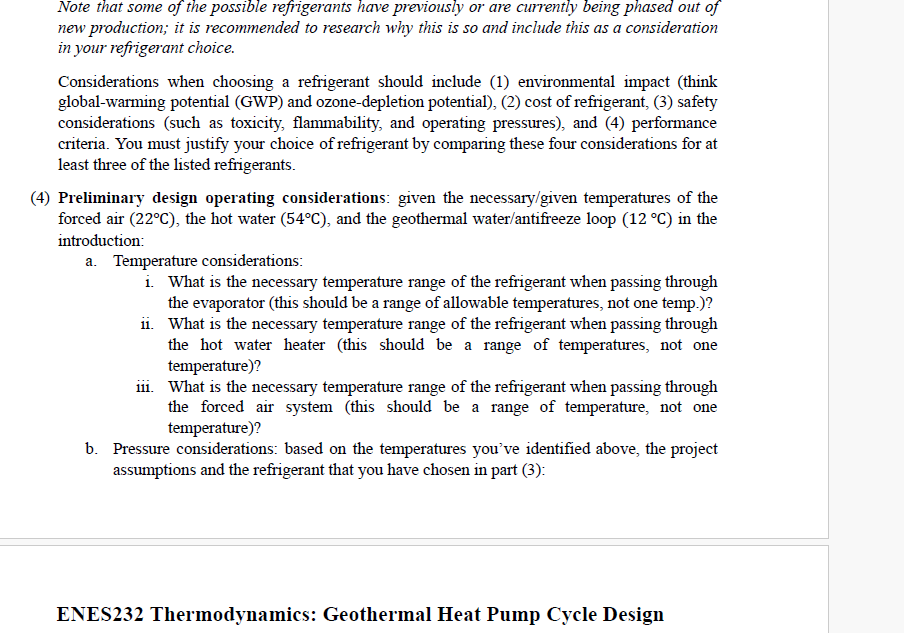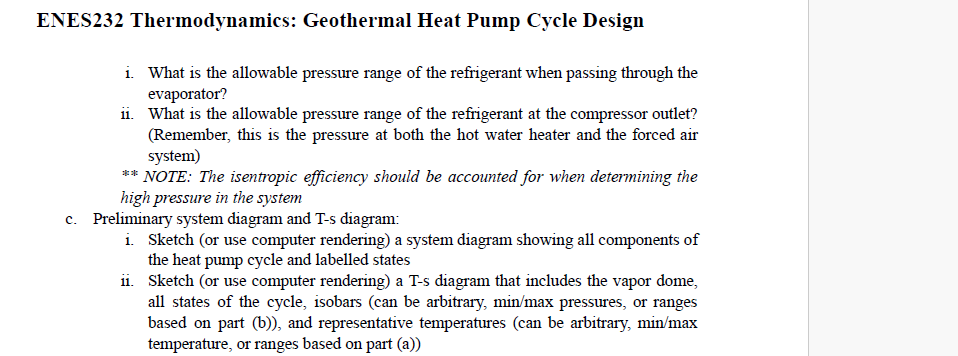Answered step by step
Verified Expert Solution
Question
1 Approved Answer
Note that some of the possible refrigerants have previously or are currently being phased out of new production; it is recommended to research why



Note that some of the possible refrigerants have previously or are currently being phased out of new production; it is recommended to research why this is so and include this as a consideration in your refrigerant choice. Considerations when choosing a refrigerant should include (1) environmental impact (think global-warming potential (GWP) and ozone-depletion potential), (2) cost of refrigerant, (3) safety considerations (such as toxicity, flammability, and operating pressures), and (4) performance criteria. You must justify your choice of refrigerant by comparing these four considerations for at least three of the listed refrigerants. (4) Preliminary design operating considerations: given the necessary/given temperatures of the forced air (22C), the hot water (54C), and the geothermal water/antifreeze loop (12 C) in the introduction: a. Temperature considerations: i. What is the necessary temperature range of the refrigerant when passing through the evaporator (this should be a range of allowable temperatures, not one temp.)? ii. What is the necessary temperature range of the refrigerant when passing through the hot water heater (this should be a range of temperatures, not one temperature)? iii. What is the necessary temperature range of the refrigerant when passing through the forced air system (this should be a range of temperature, not one temperature)? b. Pressure considerations: based on the temperatures you've identified above, the project assumptions and the refrigerant that you have chosen in part (3): ENES232 Thermodynamics: Geothermal Heat Pump Cycle Design Milestone 1: Project Scope and Preliminary Design Report (due 11/17): To complete Milestone 1 of the project, your team will write a Project Scope and Preliminary Design Report that will establish the scope and constraints of your final design. Your report should include the following items: (1) Stakeholder analysis: list the parties involved/impacted by installing the geothermal heat pump system being installed for the house, and briefly discuss the impact of the design on these stakeholders. Think beyond just the engineering company and the homeowner! (2) Economic feasibility/facility siting: find (1) an average cost of installing a 3.5 ton geothermal heat pump system for a residential home; find (2) the average payback period of time when the cost-savings of the geothermal system pay for the upfront costs of installing a geothermal system; additionally, find (3) the average footprint needed to install a geothermal heat pump system a. Based on your research, provide a description of the typical homeowner who can install a geothermal heat pump system in their home b. Is there anyone who is likely unable to install a geothermal heat pump system to heat their home? If so, discuss who they are and why they are unable to install such a system. c. What are some locations/spaces where geothermal loops could be easily or plentifully installed? (3) Refrigerant choice: You have to choose a refrigerant to use in your design! You have a choice between six refrigerants: 1. Forane Refrigerant 22 (R-22) 2. Refrigerant 410a (R-410a) 3. Refrigerant 32 (R-32) 4. Refrigerant 454b (R-454b) 5. Carbon Dioxide 6. Ammonia ENES232 Thermodynamics: Geothermal Heat Pump Cycle Design i. What is the allowable pressure range of the refrigerant when passing through the evaporator? ii. What is the allowable pressure range of the refrigerant at the compressor outlet? (Remember, this is the pressure at both the hot water heater and the forced air system) **NOTE: The isentropic efficiency should be accounted for when determining the high pressure in the system c. Preliminary system diagram and T-s diagram: i. Sketch (or use computer rendering) a system diagram showing all components of the heat pump cycle and labelled states ii. Sketch (or use computer rendering) a T-s diagram that includes the vapor dome, all states of the cycle, isobars (can be arbitrary, min/max pressures, or ranges based on part (b)), and representative temperatures (can be arbitrary, min/max temperature, or ranges based on part (a))
Step by Step Solution
There are 3 Steps involved in it
Step: 1
1 Environmental Impact GlobalWarming Potential GWP This measures how much heat a greenhouse gas traps in the atmosphere relative to carbon dioxide ove...
Get Instant Access to Expert-Tailored Solutions
See step-by-step solutions with expert insights and AI powered tools for academic success
Step: 2

Step: 3

Ace Your Homework with AI
Get the answers you need in no time with our AI-driven, step-by-step assistance
Get Started


